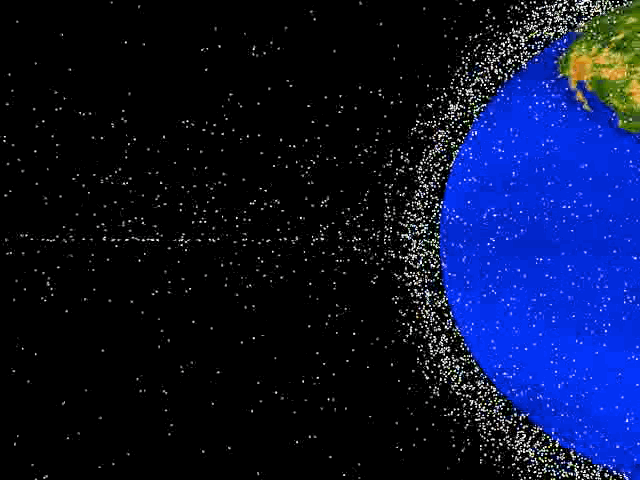Tracking space debris
As a child, Ian DesJardin found mathematics entrancing. “When you’re a little kid and believe magic is real, math and equations feel like spells,” he says. “They’re kind of this arcane knowledge that says something about reality.”
DesJardin took that magic with him into college at the University at Buffalo, where he double-majored in math and aerospace engineering. But instead of designing “the next sci-fi spaceship,” he became enthralled by plasma physics and pursued his Ph.D. at the University of Maryland on a Department of Energy Computational Science Graduate Fellowship (DOE CSGF).
Even though his graduate research doesn’t directly involve rockets, plasma physics allows DesJardin to work on space-related problems. Earth is surrounded by a plasma field that begins 90 kilometers above its surface, where the planet’s magnetic field holds the ions from its outer atmosphere in a charged layer of gas. This area, called the ionosphere, is home to thousands of satellites such as those that relay communications and GPS signals.
But the ionosphere is also full of orbiting debris such as meteoroids and broken bits of space equipment that can bombard those satellites. Collisions are catastrophic: Zooming at thousands of meters per second, objects explode on impact and create millions of fragments that stay in orbit and can hit other satellites.
Efforts to clean up the ionosphere have met with little success, and so far the best solution is for satellites to evade debris. But knowing when to dodge can be difficult since sub-centimeter particles can’t be seen on radar. “The only way we know debris is there is because it punches holes in things,” DesJardin says. At orbital speeds, even a paint chip can turn into a bullet with enough force to penetrate the International Space Station’s shields.
Luckily, these tiny particles create much larger electromagnetic ripples in the plasma layer, much like the wake of a ship. These waves, up to hundreds of meters wide, can propagate for kilometers and be picked up on antennas as radio waves. Working with Ph.D. advisor aerospace engineer Christine Hartzell, DesJardin models these waves on DOE’s supercomputers. His simulations include numerous variables, including debris material, plasma density and magnetic field strength at different latitudes around Earth.
With these models, DesJardin can calculate wave speeds and amplitude-rate decreases the farther a wave gets from the original particle. He is particularly interested in a type of wave called a soliton: a stable lump of a wave that moves ahead of the debris in the same way that water piles up in front of a ship’s bow. In space, solitons are created by temperature differences in the magnetic field. This creates waves that change the material’s density and can be easily detected with probes.
Although these models require massive amounts of supercomputing power, that cost pales compared to the expense of launching real monitoring equipment into orbit. “It’s incredibly hard to measure things in space,” DesJardin says. “We can try things in the computer a billion times that would be prohibitively expensive to try in space.” Eventually, he hopes his research could be incorporated into an early warning system that could either be mounted on a ground telescope or the satellite itself.
Meanwhile, DesJardin is working on additional plasma problems closer to home. In 2021 and 2022, he completed DOE CSGF practicums at the Princeton Plasma Physics Laboratory working with tokamaks, devices that are used in nuclear fusion research. Tokamaks rely on a magnetic field to contain high-energy plasma, but if the plasma becomes unstable and loses energy, it can escape the field and damage the machine. DesJardin has been working on machine learning models that predict when these disruptions will occur and alert scientists to shut the tokamak down in time.
After he graduates in 2024, DesJardin hopes to continue working in plasma physics at a national lab. Though he may not always study space debris, he is interested in applying his modeling know-how to other aerospace challenges such as determining how ambient plasma around the moon would affect a lunar space station. Because the moon has no atmosphere, its ionosphere reaches the ground where it electrically charges moon dust and makes it float. The plasma can also fry electronic equipment including life support systems: a crucial problem to solve before planning and building a lunar base. “It’s kind of an environmental hazard that doesn’t exist on Earth,” he says.
DesJardin says he would love to see his code incorporated into radar systems, allowing scientists to observe plasma waves directly. “But I think realistically, happiness is going to be just moving the state of the art forward.”
About the Author
The author is a freelance journalist covering biomedical, environmental and social science from Bozeman, Montana.






You must be logged in to post a comment.